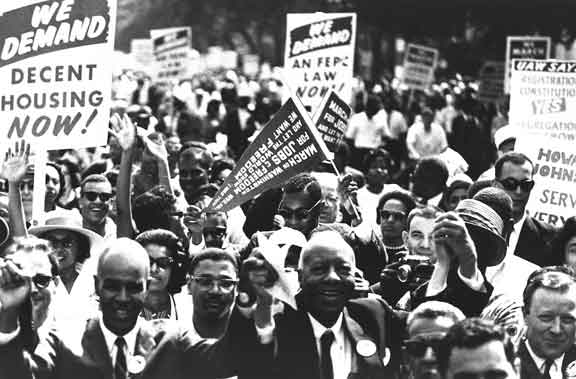Civil Rights

March on Washington
The Constitution explicitly protected slavery. The Civil War had to be fought before the "peculiar institution" was ended. Constitutional amendments passed in the aftermath of the war provided equal protection under the law for African-Americans, at least in theory. Unfortunately, with the end of Reconstruction, African-Americans were denied their legal rights in practice, and the Supreme Court upheld these infringements. It was not until the decision of the Supreme Court in 1954, in the case of Brown v. Board of Education, that the Court ruled that "separate but equal" was not equal. A series of laws and court decisions in the 1960's provided African-Americans with legal rights equal to those of the rest of nation's citizens.
The Declaration of Independence states that all men are created equal. Until the Civil War, the Supreme Court upheld slavery. In the famous Dred Scott Case, the Court ruled not only that slavery was legal, but that it was a protected right under the Constitution, and that states did not have the right to regulate it. The Civil War and the subsequent constitutional amendments put an end to any constitutional support of that view. Nevertheless, in 1875, the Court struck down the Civil Rights Act of 1875, which forbade the separation of the races in public transportation, hotels and other public places. The Court took a very narrow view of the Fourteenth Amendment concept of equal protection, claiming that it only applied to state actions, and not to individual actions. In 1896, in the case of Plessy v. Ferguson, the Court argued that separation of the races was legal as long as both races received equal treatment. Thus "Jim Crow" laws of segregation developed across the nation, and became the norm in most Southern states.
During the twentieth century, African-American organizations, such as the National Association for the Advancement of Colored People (NAACP), continually challenged segregation in the courts. In 1950, the Supreme Court ruled that separate Texas law schools for blacks and whites were unconstitutional. On May 7, 1954, the Court issued the decision in Brown v. Board of Education of Topeka, that the doctrine of "separate but equal" was not acceptable, and that separate educational facilities were inherently unequal. Outlawing segregation and actually assuring that schools became integrated, however, were two separate matters. In 1957, President Eisenhower was forced to send federal troops to Little Rock, Arkansas, to integrate the public schools there. Integration still proceeded slowly so that, by 1969, the Supreme Court ruled that the days of integration at all deliberate speed were over, and that all schools had to be integrated immediately.
The decision in the Brown case had no impact on the question of public accommodations however, so civil rights organizations began a sustained campaign to integrate southern public institutions. This led President Kennedy to propose the Civil Rights Act of 1963, which Congress passed easily after Kennedy's assasination.
 >
>